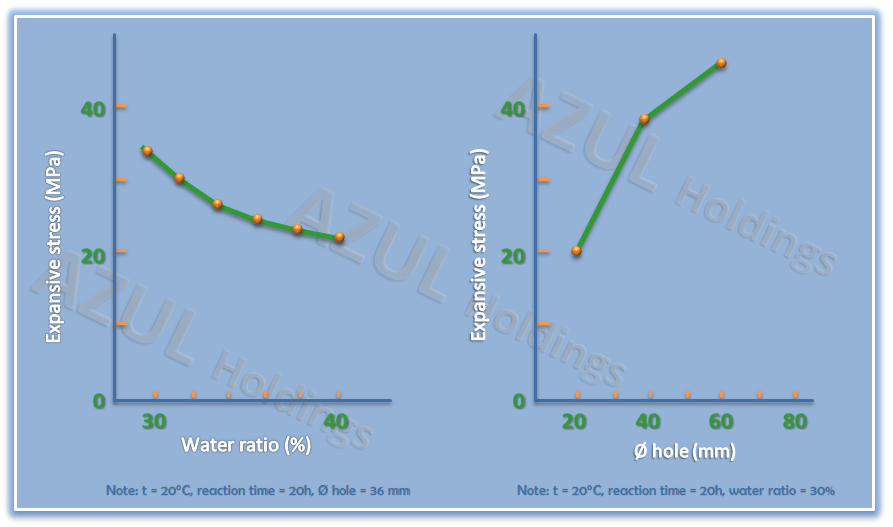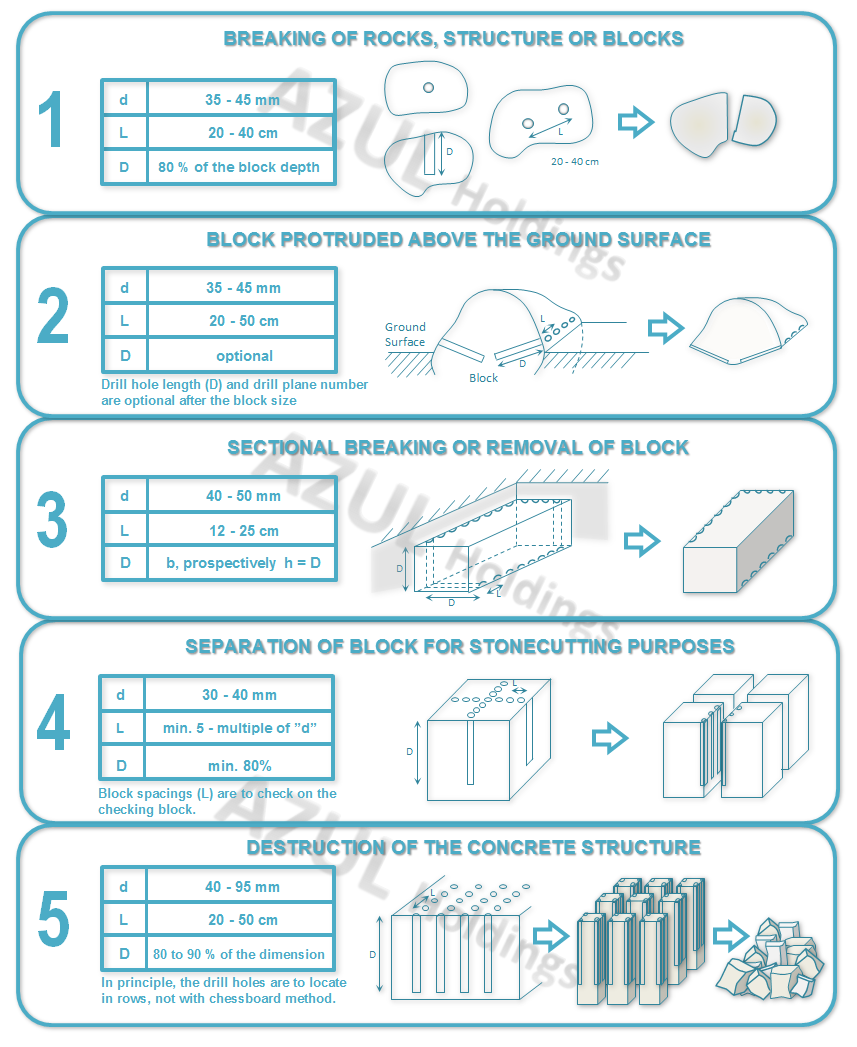KRACK-TITE
SILENT NON-EXPLOSIVE DEMOLITION AGENT
- Description
- Fields of Application
- Features and Benefits
- Quantity of KRACK-TITE
- Application Procedure
- Expansive Stress Diagram
- Application
- Composition, Packaging, Storage and Shelf Life
- Typical Applications
Description
KRACK-TITE is a soundless and environmentally safe non-explosive demolition agent having the capability of demolishing rocks or concrete structures safely without causing noise, vibration or environmental pollution.
KRACK-TITE creates systematic cracking in concrete and rock making secondary breaking easier, safer and quicker to complete.
Fields of Application
- KRACK-TITE is ideally suited for all demolition work but particularly where the use of explosives will cause damage, pollution, danger of inconvenience to the surrounding environment.
- Quarries, demolition works, breaking out before concrete repair and mining are some of the areas where KRACK-TITE will save the user time, money and inconvenience.
Features and Benefits:
- Noise and vibration free.
- Environmentally friendly, no dust, flyrock, gas or debris.
- Easy to mix with drill and paddle.
- Less hazardous than conventional methods.
- No license or special expertise required for usage.
- Expansive stress of more than 30N/mm2.
- Economical-savings in manpower, product cost and removal of waste.
- No special security required for storage.
QUANTITY OF KRACK-TITE PER 1M LENGTH OF HOLE DIAMETER
Consumption of KRACK-TITE depends on the strength properties of the rigid system to be disconnected.
- In soft rocks: 0.5-8.0 kg/m3
- In stiff rocks: 5.0-11.0 kg/m3
- In plain concrete: 7.0-13.00 kg/m3
- In reinforced concrete: 13.0-21.00 kg/m3
KRACK-TITE consumption (Kg) per ONE Metre length of the hole diameter:
| Diameter of the bore (mm) | 30 | 32 | 36 | 38 | 40 | 42 | 44 | 46 | 48 | 50 |
| Consumption (kg/linear metre) | 1.1 | 1.3 | 1.6 | 1.8 | 2.0 | 2.2 | 2.4 | 2.7 | 2.9 | 3.1 |
Hole Diameter
In all cases the minimum hole diameter should be 30mm. The larger the hole diameter is, the greater the expansive stress becomes. The hole size however is recommended to be no greater than 50mm.
Expansion
Within one hour the KRACK-TITE suspension in the hole hardens and begins to hydrate. During hydration KRACK-TITE expands and this expansive stress is depending on such factors as hole diameter and water ratio. The demolition effect takes place in 6-24 hours.
Application Procedure
Preparation of Substrate
There is also temperature dependence of the mix water on the temperature of the rigid system. Water temperature affects the effects of KRACK-TITE substantially, especially within the range of temperatures from -7 °C to +5 °C. In this case it is recommended to use the highest possible water temperature. As determining temperature of the rigid system, it should be considered the time of the bore filling with suspension.
| Temperature of the rigid system | Temperature of the mix water |
|---|---|
| above +25 °C | below +10 °C |
| +15 to +25 °C | +20 to +25 °C |
| +5 to +15 °C | +25 to +40 °C |
| -7 to +5 °C | +40 to +95 °C |
Hole Depth and Hole Spacing
Hole spacing will vary depending on the type of rock, concrete or substrate etc. to be removed. The following tables however provide guidelines to work from:
HOLE DEPTH
| Kind of object | Hole depth |
|---|---|
| Rock/Boulder | 80% of height |
| Concrete | 90% of height |
HOLE SPACING
| Rock | Hole Spacing |
|---|---|
| Hard Virgin Rock | 40-60 cm |
| Soft Virgin Rock | 60-70 cm |
| Concrete | Hole Spacing |
| Unreinforced Concrete | 40-70 cm |
| Reinforced Concrete | 20-40 cm (dependent on quality of re-bars) |
Dosage and Mixing
- Pour clean water into a bucket or drum and gradually mix KRACK-TITE in the water at a ratio of 30 wt% of water while stirring the mixture with an auto-mixer or with hand mixer.
- The ratio of 1.5 liters of water should be mixed with a 5 kg unit of KRACK-TITE. Stir the slurry well to a good consistency and use the mixed slurry as soon as possible (within 15 minutes).
Expansive Stress Diagram

Application
- KRACK-TITE should be poured into the holes Within 10 minutes of mixing the water and powder.
- Drill horizontal holes with a slight slope to help filling.
- Once the KRACK-TITE's fluidity is gone it should not be re-mixed with water as the strength is greatly reduced.
- KRACK-TITE must be poured into the hole to its brim.
- Spraying the surface with water and keeping it wet after the cracks initiate tends to increase the width of cracks and speeds the cracking process.
- Covering the filled hole with a plastic cover is desirable to avoid dilution of KRACK-TITE from external water source until cracking starts.
Recommended Mixing Equipment
- Metal or plastic bucket
- Measuring cylinder
- Protective rubber gloves and goggles
- Safety helmet
- Mechanical mixer and paddle
Temperature
KRACK-TITE can be used in temperatures ranging from 10 °C to 40 °C.
Coverage
As per guidelines.
Composition
KRACK-TITE is a white powder essentially consisting of binding materials mixed with special organic expansive compounds.
Packaging
KRACK-TITE is packed in 5 kg buckets.
Storage and Shelf Life
Store the product in dry, cool area and keep it away from moisture (the same as OPC). The minimum shelf life is 6 months.
Watchpoints
- Keep KRACK-TITE away from moisture.
- Use water to wash off KRACK-TITE sticking to body.
- Do not look into the holes filled with KRACK-TITE. When mixing and filling holes always wear rubber gloves, safety glasses and helmet.
- Do not store KRACK-TITE slurry in bottles or cans but after mixing fill it as soon as possible into holes.
- There should be no entry for unauthorized people to the place where KRACK-TITE is in use.
- Do not use KRACK-TITE for other purposes besides the cracking of rocks or concrete.
Typical Applications





